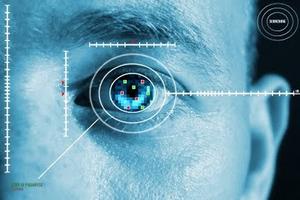Biometric Consortium Conference & Expo 2011Predicting race and ethnicity from irises now possible
Conventional wisdom holds that irises, like fingerprints, are unique to each individual and have little similarities between ethnic groups or gender, but a groundbreaking new study indicates that biometric scanners can actually predict race and gender based on iris texture alone; the study’s findings are important in that it opens new avenues for research that previously were not thought possible

Iris scan now claims to identify ethniviy // Source: ning.com
Bowyer found he had a more difficult time predicting the ethnicity of females with an 82.8 percent accuracy rate compared to 87.5 percent foConventional wisdom holds that irises, like fingerprints, are unique to each individual and have little similarities between ethnic groups or gender, but a groundbreaking new study indicates that biometric scanners can actually predict race and gender based on iris texture alone.
Speaking at the Biometric Consortium conference in Tampa, Florida, Dr. Kevin W. Bowyer, a professor at the University of Notre Dame and the chair of its Department of Computer Science and Engineering, showcased his research which found it is in fact possible to predict demographic factors like ethnicity and gender.
Bowyer said according to current thinking, “everybody’s iris completely independent and randomly different from everybody else’s,” which would make my research impossible, but “I’m trying to say, ‘No, there are similarities shared by groups of people.’”
Eschewing the existing method of examining irises, Bowyer analyzed iris texture in a novel way to find similarities between ethnic groups and gender by breaking down the iris into a total of 882 data points.
To test the viability of these data points, Bowyer and his team studied the irises of 120 people – thirty Asian males, thirty Caucasian males, thirty Asian females, and thirty Caucasian males. In total, the researchers created a database of 1,200 images to examine by taking five photos of each individual’s iris.
In comparing Asian irises to Caucasian irises, Bowyer was able to predict ethnicity with 90 percent accuracy. Meanwhile, in an interesting turn, with female and male only datar males.
Furthermore, Bowyer determined that it was also more difficult to predict gender based on iris texture with a 62 percent rate of accuracy.
Bowyer said the research is still in its early phases, but the study’s findings are important in that it opens new avenues for research that previously were not thought possible.
The results clearly indicate “you can do some things that you might not have thought you could do with iris detection, [and] we’re really curious about what else you [can] do,” he said.
As Bowyer continues his work, he hopes to improve the accuracy of predictions, test his results against a broader range of ethnicities, and explore other demographic factors to see what else is possible.
